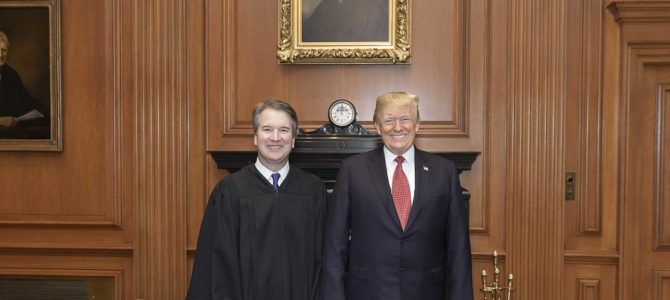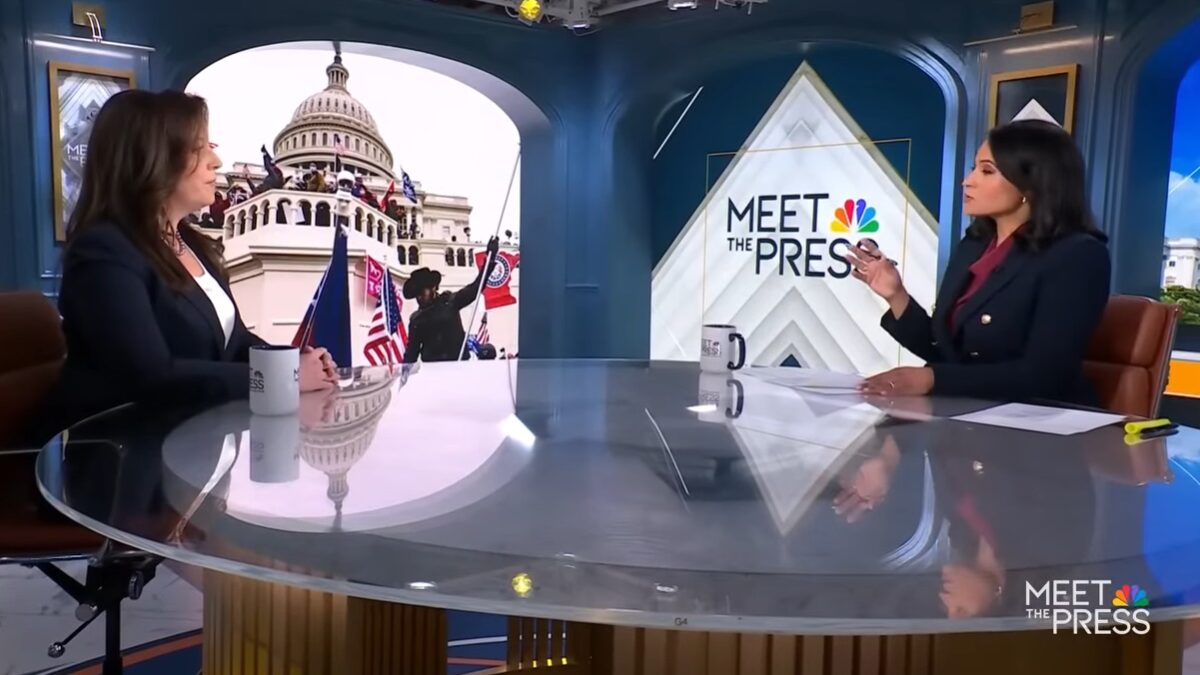
Last year, Democrats tried every trick in the book to prevent Brett Kavanaugh from being confirmed to the Supreme Court. They failed. Now, they’re at it again.
Kavanaugh was confirmed and seated on the court, but for a certain kind of rabid political mind, that fact is no hindrance. From the internet fever swamps of the left-wing commentariat, plans have emerged to remove Kavanaugh from the court by any means necessary. The madness has even spread to Congress, with radicals in the House calling for impeachment already.
Federal judges serve for life, or until they retire, and the only way any judge’s tenure has ever been cut short besides that has been through the impeachment process described in the Constitution. So the anti-Kavanaugh people seem to have a nearly impossible task: asking a Senate that just confirmed him with a majority of votes to unseat him with a super-majority. Faced with the cold truth of the Constitution and the hard math of the Senate, they have instead floated a variety of crackpot theories that will let them do what they want anyway.
A Removal Theory Made of Thin Air
For now, most voters are happy to move on and settle our political differences in the traditional way: at the ballot box. But as we saw earlier this week in Vox, clever minds are at work in subverting the independent judiciary. Ian Millhiser, late of the defunct ThinkProgress blog, now a correspondent for Vox, led the charge.
Drawing on a 2006 law review article by professors Saikrishna Prakash and Steven D. Smith, Millhiser puts forth the idea that there are other, never before imagined, ways of removing federal judges from the bench. (Professor Aziz Huq of the University of Chicago wrote a similar article last year in the Washington Post, also citing Prakash and Smith.)
Millhiser makes much of the authors’political orientation, saying that they are conservative, so this is no lefty trick. It’s the same perverse appeal to authority that featured in the Obamacare debates, when the existence of a similar plan by a Heritage Foundation scholar was trumpeted as evidence of its bipartisan appeal.
Normally, leftist authors would use the professors’ politics in ad hominem attacks to dismiss their scholarship; when the scholarship is useful, though, the attacks are reversed without a hint of embarrassment. A neat rhetorical trick.
Define ‘Good Behavior’
The Prakash and Smith article is mainly an examination of the term “good behavior.” We say that federal judges have their jobs for life, but the exact phrasing of the constitutional provision is that “Judges, both of the supreme and inferior Courts, shall hold their Offices during good Behavior.” “Good behavior” here is a legal term of art with hundreds of years of precedent behind it in English history. Prakash and Smith looked into what, exactly, that meant.
English kings once appointed and removed judges by whim, so the “good behavior” phrase was originally a safeguard against that, a step on the road toward an independent judiciary. What it meant, in essence, was that to remove a judge from office, a king had to prove he “had misbehaved and thus had violated the conditions attached to his commission.” The guarantee was likely designed to attract better judges, men who did not want their tenure to be determined by whether the king liked their rulings.
After the many abuses of the judicial system by the monarchs of the Stuart dynasty, judicial independence became important in English law and, later, was included in America’s state and federal constitutions. Judges, it was agreed, should be secure in their tenure, and only removable after a trial, or something like one.
Constitutional Changes Require Amendments
In some early state constitutions, impeachment was just one of several ways of accomplishing this. Prakash and Smith cite Delaware’s original constitution of 1776. “After granting various officers tenure during good behavior, the Delaware Constitution noted that all officers shall be removed ‘on conviction of misbehavior at common law, or on impeachment, or upon the address of the general assembly.’”
There are a variety of ways a state could choose to remove a judge, and not every state chose impeachment as the sole means of doing it. “Address of the general assembly,” for instance, followed English law in allowing the legislature to remove a judge by majority vote.
On the other hand, the federal Constitution discusses only one means of removing a civil officer: impeachment by the House and conviction in the Senate. Millhiser mentions the case of Judge Roy Moore’s suspension from the Alabama Supreme Court “by a special court that hears complaints against the state’s judges.” Could not the federal government create a similar method of reigning in judicial misbehavior?
Well, they could, but exactly how they might do so would frustrate the radicals’ plans. If they want to follow the Alabama precedent—which might be a first for Millhiser and Vox—they have to ask, how did the Alabama Court of the Judiciary get the power to police the behavior of the state’s judges? The answer: by constitutional amendment.
In 1973, Alabama passed Amendment 328 to their state constitution. That amendment, among other things, established a Judicial Inquiry Board and the Court of the Judiciary. If the federal government wanted a similar system, they could have it—but it would require the same method to bring it about.
Until Then, We Still Have to Follow the Constitution
In the meantime, it is hard to imagine a system of removal that would meet the requirements of the Constitution other than the one specifically mentioned in the Constitution. And American history confirms that point. While there were many methods of judicial removal in England and colonial America, the only way federal judges have ever been removed from office is through impeachment and conviction.
Millhiser writes of this as a norm, but it is rather more than that. The Constitution did not wipe out all legal precedent before it, but it did establish a new basic law to which all preceding law must now conform. Some states provided alternate removal methods in their constitutions, which shows it is possible. But the federal Constitution’s drafters, who were aware of those state constitutions (and in some cases had helped write them) chose not to replicate those provisions.
That alone is a persuasive argument that they did not intend any removal method but the one they did include. Although Prakash and Smith cite some language in the 1790 Crimes Act that could possibly be interpreted to suggest that Congress considered alternate methods, that language could also just as easily be meant to show simply that federal judges may be convicted of crimes while on the bench—something that has happened several times in our history.
This is a sticking point for Millhiser. He seems concerned that if Kavanaugh is convicted of a crime—which he believes likely, apparently—the Senate would refuse to remove him from office. This is at odds with historical practice: when judges have been convicted of crimes in the past, Congress has impeached and removed those who tried to hang on to their seats.
This is not ancient history, either: district judges Harry Claiborne, Alcee Hastings, Walter Nixon, and Thomas Porteous were convicted in the Senate over the past 40 years, one of them (Porteous) as recently as 2010. A functioning system already exists for removing judges whose behavior is shown to be bad.
Politicized Impeachment Is the Goal
Earlier attempts at impeachment show the real problem with the process dreamed of in the Vox article. The impeachments of Judge John Pickering and Justice Samuel Chase show how removing judges from office more frequently poses a threat to judicial independence and American liberty.
Jeffersonians (retrospectively known as the Democratic-Republicans) opened the 8th United States Congress with large majorities in both houses and their party leader in the White House. The judiciary, however, was packed with Federalists appointed by George Washington and John Adams. That tension showed most clearly in 1803, when John Marshall and the Supreme Court frustrated the Jeffersonians in Marbury v. Madison, striking down a federal law for the first time.
A month later, the House Democratic-Republicans impeached Judge Pickering. Pickering was not a Supreme Court justice, but a district judge from New Hampshire, and not involved at all in the Marbury decision. But he was a Federalist, and a good test case for the power of Congress to reshape the judiciary: for years, Pickering had been unable to do his job because of a combination of declining mental faculties and habitual drunkenness. Poverty and stubbornness kept Pickering from resigning, and his failure to perform his duties made him a tempting target in the effort to open up more Federalist-held seats.
Some among the Democratic-Republicans, including Jefferson, were concerned that insanity was not suitable grounds for impeachment, but they soon agreed they had no other option. Jefferson wrote privately that it showed the need for a system of removal by address, as Britain had. But he also agreed that no such power existed, and his allies in Congress moved forward with the impeachment. The Senate convicted Pickering 20 to 6 on March 12, 1804, with even some Federalists abandoning the judge.
That very day, the House set its sights on a bigger target: Justice Samuel Chase of the Supreme Court. A Washington appointee and arch-Federalist, Chase was the Jeffersonians’ primary foe on the Supreme Court. Besides his rulings, he also publicly criticized Jefferson and condemned Democratic-Republican policies from the bench, including during a grand jury charge. Yet, as in Pickering’s case, no crime had been committed. Buoyed by their success, though, the House impeached him anyway.
The charges focused on his rulings, which the House managers claimed were so wrong and prejudicial as to constitute judicial misconduct. The consequences of that line of reasoning, perhaps, were what stayed the Senate’s hand after Chase’s trial there.
There were separate votes on all eight articles of impeachment, but enough Democratic-Republicans sided with the Federalists on each vote as to defeat all eight. That ended the Jeffersonian drive to purge the bench of political opponents and established a precedent against politically motivated impeachment. Chase remained on the Supreme Court until his death in 1811, and no Supreme Court justice has been impeached since.
We Have a Congress For This, and It’s Not Acting
This, more than anything, is the point of the Vox article. Millhiser believes Kavanaugh should not be on the Supreme Court, just as Jefferson and his allies believed Chase should be removed. But in neither case did either justice commit any crime while in office, nor did either of them show themselves to be objectively unfit for the job.
Millhiser fantasizes about Kavanaugh in prison for perjury and wonders how the Supreme Court could function with a justice behind bars. But the examples of Claiborne, Hastings, Nixon, and Porteous, show that Congress is perfectly willing to remove a judge from the bench if he has been convicted of a crime.
Prakash and Smith suggested that there might be alternate methods of removing a judge; Millhiser is calling for that, but also for an alternate standard, one that goes well beyond the “good behavior” tenure required by the Constitution. Vox and their readers on the far left want a new Star Chamber, a special super-court stacked with like-minded judges who would go around the words and precedents of the Constitution and do what Jefferson could not: purge the courts of their ideological enemies.
The fig leaf of “misbehavior” is clearly a ruse when it is applied retrospectively across a justice’s entire life. This is no constitutional alternative. It is cancel culture for the judicial branch.
The ex post facto assault on the bench is born out of fear. Having seen Donald Trump appoint two Supreme Court justices and 150 lower court judges to lifetime appointments, they are anxious about what the next year (or five years) may bring. But in trying to steer their base toward lawlessness, they would chip away at the independence of the judiciary, an essential part of the separation of powers that protects us all from over-powerful government.









